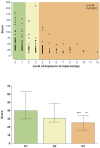Are you good enough for your patients? The European certification model in laparoscopic surgery
- PMID: 24753896
- PMCID: PMC3987500
Are you good enough for your patients? The European certification model in laparoscopic surgery
Abstract
Quality control, training and education in gynaecological surgery are challenged and urgent measures are emerging. The implementation of a structured and validated program for training and quality control seems the most urgent measurement to be taken. The European Academy of Gynaecological Surgery has made a first attempt to do so. Through a practical and theoretical tests system, the skills of an individual surgeon is measured and the conditions to enter the different level of expertise are clearly defined. This certification system based on the best possible level of scientific evidence provides a first practical tool, universally implementable for a decent quality control and structured training program in Gynaecological laparoscopic surgery.
Keywords: Laparoscopy; certification; education; psychomotor skills; training.
Figures




References
-
- Walsh CJ, Capes T. An evaluation of the resident learning curve in performing laparoscopic supracervical hysterectomies as compared with patient outcome: five-year experience. J Minim Invasive Gynecol. 2007;14:719–723. - PubMed
-
- Brunner WC, Korndorffer JR, Jr. , Sierra R. Determining standards for laparoscopic proficiency using virtual reality. Am Surg. 2005;71:29–35. - PubMed
-
- Brunner WC, Korndorffer JR, Jr. , Sierra R. Laparoscopic virtual reality training: are 30 repetitions enough? J Surg Res. 2004;122:150–156. - PubMed
-
- Campo R, Reising C, Van Belle Y. A valid model for testing and training laparoscopic psychomotor skills. Gynecol Surg. 2010;7:133–141.
-
- Fraser SA, Feldman LS, Stanbridge D. Characterizing the learning curve for a basic laparoscopic drill. Surg Endosc. 2005;19:1572–1578. - PubMed
LinkOut - more resources
Full Text Sources
